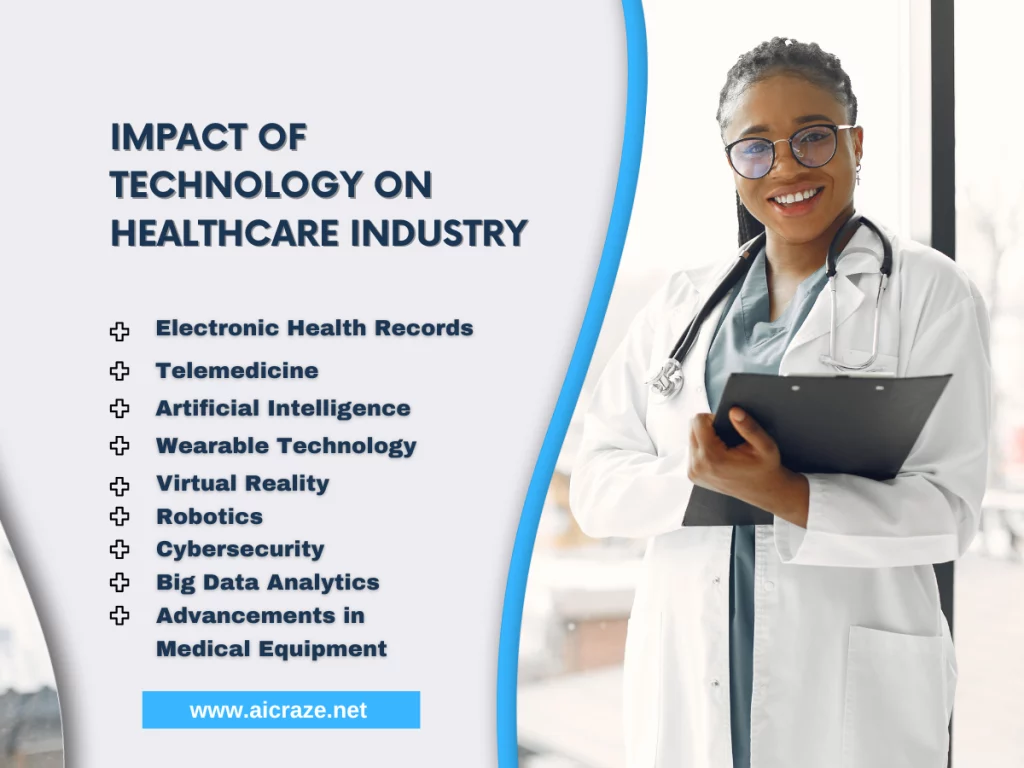
Technology has revolutionized the healthcare industry in numerous ways, from electronic health records to telemedicine, artificial intelligence, and virtual reality. The impact of technology on healthcare has improved patient outcomes, reduced healthcare costs, and increased the efficiency of healthcare providers. In this article, we will explore what is the impact of technology on healthcare industry.
Electronic Health Records
Electronic health records (EHR) are digital versions of a patient’s medical record that can be accessed and updated by healthcare providers in real time. EHRs have significantly improved healthcare delivery, communication, and quality of care. They allow healthcare providers to have access to a patient’s complete medical history, which can help them make more informed decisions about treatment plans. EHRs also help to reduce medical errors, improve patient safety, and increase efficiency in healthcare delivery.
One of the most significant benefits of EHRs is their ability to improve communication between healthcare providers. EHRs allow healthcare providers to share patient information, test results, and treatment plans with other healthcare providers involved in the patient’s care. This improved communication can lead to better coordination of care and improved patient outcomes. This is the positive impact of technology on healthcare but there are also a few drawbacks to this.
However, there are also potential drawbacks to EHRs. The implementation of EHRs can be costly and time-consuming for healthcare providers. Additionally, concerns about data privacy and security have been raised, as EHRs can contain sensitive patient information that must be protected from cyber threats.
Telemedicine
Telemedicine is the use of technology to provide remote healthcare services, including consultations, diagnosis, and treatment. It has become increasingly popular in recent years, particularly during the COVID-19 pandemic, as it allows patients to receive care from the comfort of their own homes. Telemedicine has numerous benefits, including improved access to healthcare services, reduced healthcare costs, and increased efficiency.
One of the primary benefits of telemedicine is its ability to improve access to healthcare services, particularly for patients in rural or underserved areas. Telemedicine allows patients to receive medical care without having to travel long distances to see a healthcare provider. This improved access to care can lead to better health outcomes for patients. This is the positive impact of technology on healthcare but there are also some limitations to this.
However, there are also limitations to telemedicine. Telemedicine relies on technology, and patients may not have access to the necessary technology or reliable internet connection to receive care. Additionally, telemedicine may not be appropriate for all medical conditions, and in some cases, an in-person consultation may be necessary.
Artificial Intelligence
Artificial Intelligence (AI) has the potential to transform healthcare by providing predictive analytics, identifying patterns in data, and personalizing treatment plans. AI can be used to analyze large amounts of patient data, such as medical records, test results, and imaging scans, to identify trends and patterns that can help healthcare providers make more informed decisions about treatment plans.
One of the most significant benefits of AI in healthcare is its ability to personalize treatment plans for individual patients. By analyzing patient data, AI can help healthcare providers develop treatment plans that are tailored to a patient’s specific needs, which can lead to improved patient outcomes. This is the positive impact of technology on healthcare but there are also a few limitations to this.
However, there are also limitations to the use of AI in healthcare. AI relies on accurate and complete data, and if the data is incomplete or inaccurate, the AI algorithms may not be effective. Additionally, concerns about data privacy and security have been raised, as AI algorithms can contain sensitive patient information that must be protected from cyber threats.
You can also read: Artificial Intelligence In Medicine: Today And Tomorrow
Wearable Technology
Wearable technology has become increasingly popular in recent years, with devices. Such as fitness trackers, smartwatches, and health monitors that people use to track their fitness goals and monitor their health. In healthcare, wearable technology has several potential benefits, such as allowing doctors to monitor patients remotely. It reduces the need for hospitalization and encourages patients to take a more active role in their healthcare.
For example, patients with chronic conditions such as diabetes or heart disease can use wearable technology to track their blood sugar or heart rate. This can help them make more informed decisions about their health. This is the positive impact of technology on healthcare but there are also a few potential drawbacks of this.
However, there are also some potential drawbacks to using wearable technology in healthcare. One concern is the accuracy of the data collected by these devices, which may not always be reliable. Another concern is the privacy of patient data, as wearable technology may collect sensitive health information. Unauthorized individuals could access it.
Virtual Reality (VR)
Virtual reality (VR) is a technology that has been used in healthcare for a variety of purposes. Such as pain management, rehabilitation, and treatment of mental health disorders. For example, we can use VR to distract patients during painful medical procedures, such as chemotherapy or radiation therapy. We can also use it to help patients with anxiety disorders or phobias by providing a safe and controlled environment for exposure therapy.
The benefits of using VR in healthcare include its ability to provide a more immersive and engaging experience for patients. This can increase their motivation and adherence to treatment plans. This is the positive impact of technology on healthcare but there are also a few potential drawbacks of this. Such as the cost of the technology and the need for trained healthcare professionals to operate it.
Robotics
We use Robotics in healthcare for various purposes, such as surgical procedures, patient care, and medication dispensing. For example, we use robots to perform minimally invasive surgeries, which can reduce patient recovery time and minimize scarring. We can also use this to assist with patient care, such as lifting and moving patients who have mobility issues.
The benefits of using robotics in healthcare include their precision and accuracy. This can lead to improved patient outcomes, as well as their ability to reduce the workload of healthcare professionals. This is the positive impact of technology on healthcare but there are also a few potential drawbacks of this. Such as the cost of the technology and the need for specialized training to operate it.
Cybersecurity
As technology continues to evolve in healthcare, cybersecurity threats have become more common. Healthcare organizations are particularly vulnerable to cyber-attacks because they often store sensitive patient information, such as medical records and insurance information. A cyber attack can lead to the theft of patient data. Hackers can use this for identity theft or other malicious purposes.
To protect against cybersecurity threats, healthcare organizations need to implement robust security measures, such as firewalls, encryption, and access controls. They also need to provide training to their employees on cybersecurity best practices. Such as not clicking on suspicious links or downloading unknown files.
Big Data Analytics
Big data analytics is the process of analyzing large and complex datasets to identify trends, patterns, and insights that can improve healthcare outcomes. It involves collecting data from various sources. Such as EHR, wearables, and medical devices, and using advanced analytics tools to extract insights.
Big data analytics can help healthcare providers identify high-risk patients, personalize treatment plans and optimize resource utilization. This is the positive impact of technology on healthcare but the use of big data analytics also raises concerns about patient privacy, data security, and the accuracy of data.
Advancements in Medical Equipment
Technology has led to the development of advanced medical equipment such as 3D printing, robotic surgery systems, and imaging technology. These advancements have revolutionized healthcare by improving diagnostic accuracy, reducing complications, and enabling less invasive procedures. For example, 3D printing technology can be used to create personalized prosthetics, implants, and surgical models.
Robotic surgery systems allow surgeons to perform precise and complex procedures with greater accuracy and control. Imaging technology such as MRI and CT scans provide detailed images of internal organs, enabling early detection of diseases. This is the positive impact of technology on healthcare. But the use of advanced medical equipment also raises concerns about the cost of healthcare, the need for specialized training, and the potential for technical failures.

